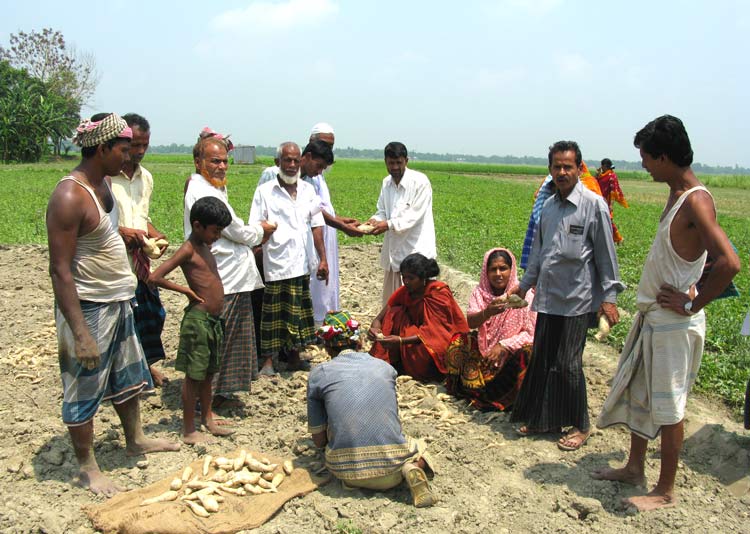Meeting with farmers for practicing and strengthened biodiversity based ecological agriculture

Annual brief report 2013 -2014
Regular meetings on biodiversity based ecological agriculture were held in the selected villages for presentation of the principles of ecological agriculture among the farmers and other members of the society. Thirty eight community meetings were held in the twenty selected villages in five districts. Two such meetings were held in the bigger villages while only one meeting was held in each of the smaller villages. The main purpose of holding these meetings was to identify the interested farmers for persuasion of ecological agriculture.
There was interactive discussion in this meeting among the farmers. Some of the farmers had critical questions - how to raise crops without the application of chemical fertilizer and pesticides? Since they have been used to chemical agriculture for quite a long period of time. In reply the ecological farmers mentioned that the use of cow dung, ash, compost, green manure, and other form of organic stuff are more compatible for enrichment of soil nutrient status. Under these circumstances the farmers desired for exposure to biodiversity based ecological agriculture through appropriate training. Accordingly training programs were organized for the interested farmers.
General Learning Sessions (GLS)
General Learning Session (GLS) is the key to introduction for practicing biodiversity based ecological agriculture. The GLS offers scope to the farmers for learning about the methodology of biodiversity based ecological agriculture. The biodiversity based ecological agriculture stands on ten principles. These principles are discussed and the farmers are oriented to system yield of crops and other productions.
- The major areas covered in the GLS include the following;
- Productive use of biological and genetic potential of plant and animal genetic resources
- Profitable and efficient production system through integrated management of resources and conservation of soil, water, energy, biodiversity and environment.
- Incorporation of nutrient cycling, nitrogen fixation and pest predator relationship into production
- Use of local knowledge and practices through innovative practices
- Matching advances in farming system, productive potential of crops and plants, fine tuned with climate change variations in order to ensure long term sustainability
- Reduction of the external and non renewable inputs in terms of chemical fertilizer, herbicides, pesticides, irrigation with ground water and land preparation with tractor and power tillers.
- Self reliance of farmers and other professional group of society
- Mixed cropping, inter cropping, relay inter cropping and crop rotation are discussed for managing disease pest infestation and crop diversification
During this reporting period 179 farmers participated in the learning sessions. As compared to plan additional 66 farmers based on their interest participated in the GLS.
The farmers clear understood that local environment of poisons with introduced of modern method of agriculture. They were happy to make comparative assessment of their indigenous technologies with those of modern technologies. They found that the indigenous technologies were more environment friendly, cost remunerative and hygienic.
Outcome of the the General Learning Sessions
The participating farmers in the GLS have started implementation of the principles of the ecological agriculture in their homestead and field near their homestead areas. All of them have started making compost and application of compost, cow dung and other organic manures for improvement of soils. They have also started following activities:
- Growing crops with seeds of indigenous varieties of crops.
- Practicing mixed cropping and multiple cropping
- Plowing the land with country plow and bullock.
- Keeping seeds of the local varieties of crops in their own hand
- Growing timber, medicinal and fruit bearing plants in the homestead and other open areas
- Exchanging seeds in the community
- Rearing poultry birds and livestock of local breeds
- Growing seasonal vegetables including red amaranth, cucumber, sweet gourd, ash gourd, sponge gourd, teasel gourd, pointed gourd, water gourd, amaranth, Indian spinach, okra, beans, snake gourd, bitter gourd etc of local varieties in the homestead areas and also in the field.